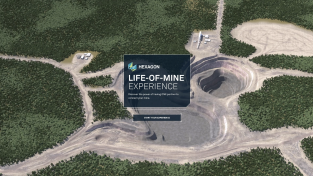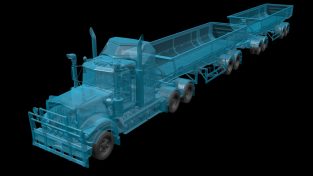The smart digital reality embodied by radar, geodetic and geotechnical sensors aggregated into one comprehensive software can bring profound benefits to slope stability monitoring. Hexagon’s MineMonitoring portfolio is built on 24/7 technical support, advanced data interpretation and tailored training. The recent addition of IDS GeoRadar’s SLYX Slow Movement Analysis brings millimetre accuracy to monitoring of tailing dams over long periods of time.
NJ: Thanks for tuning in. Hi, I’m Neville Judd from HxGN Radio.
The smart digital reality embodied by radar, geodetic, and geotechnical sensors aggregated into one comprehensive software can bring profound benefits to slope stability monitoring. With us to discuss Hexagon’s monitoring solutions and the latest advancements in tailing dams analysis is IDS GeoRadar director of Monitoring Radar Product Management, Francesco Coppi. Francesco, thanks for joining us today.
FC: Hi, Nev. Thank you for this opportunity to talk about our products and how they can address the typical mining needs.
NJ: You bet. Pleasure to have you aboard.
So, Francesco, give us an overview of Hexagon’s Mine Monitoring portfolio and how it meets the mine’s stability monitoring needs.
FC: Yeah. In a short answer, Hexagon’s Mine Monitoring portfolio provides a solution for any monitoring need, thanks to the ownership of a wide range of technologies closely integrated to each other by means of easy-to-use and easy-to-configure software solution. But anyhow, to be more specific, I will try now to explain with practical example how the mine monitoring portfolio can address the different monitoring needs.
For instance, the combined use of IDS long-range slope monitoring radar, like IBIS-FM and the ArcSAR along with Leica Total Station and GNSS, can perfectly cover the needs to have a background long-term monitoring of large pits as well as tailing dams by providing real-time alert in case of hazardous displacement acceleration, visibility of the slope deformation, or slow slope deformation trend with the possibility to develop solutions before the displacement begins to interfere with the mining operation, and as well as to have a better geological understanding of the short- or long-term deformation of a detected slope instability issue. Instead, the monitor is another example of complex extraction scenario, for instance, characterised by complex geometries or the presence of many medium-sized pits can be addressed by the flexibility of ArcSAR Lite or the need to have a focused monitoring of known sub-bench slope instability close to the working area can be managed by HYDRA-X. That is a compact and portable solution, quickly deployable and capable to provide at the same time fast scans and high resolution for a quick reaction, even in case of sudden acceleration of smaller areas. And at the same time, the flexibility of HYDRA-X and ArcSAR Lite also represent a solution to the needs of coal strip mining, which requires a frequent relocation of the system to always monitor the area recently excavated.
Another important tool of our product portfolio is represented by RockSpot, which can detect and track rockfall in real time while it is happening. RockSpot it is the answer to the need to mitigate rockfall hazard, which is one of the main source of incidents today in open mine. In addition to that, the Hexagon Geomonitoring hub permits to fuse together all the measurement coming from slope monitoring radar, Leica geodetic equipment, InSAR satellite or other geotechnical sensor and provide a holistic view of the mine slope stability condition.
And as I tried to summarise, we have an answer to almost any possible monitoring needs. And if for some reason we don’t have it, we are committed to find one and fill the gap.
NJ: Right. So numerous, numerous solutions responding to a multitude of challenges.
Let’s talk about tailing dams for a moment. Incidents in recent years have shown us the tragic consequences of failures in tailing dams. What role can technology play in helping to prevent such incidents?
FC: Over the last years, there have been too many tailing dam collapses, which caused the unacceptable, large number of casualties. And a certain number of those tragic events can be strictly related to a not proper design of the tailings dam. Nevertheless, even in those cases, the application of a proper monitoring strategy could have helped to save many lives. And then what we have learnt from the past events is that tailing dam collapses can be either anticipated by almost no deformation, so no deformation then a sudden collapse of the dam, or a slow deformation trend with the sudden acceleration immediately before the collapse.
These two behaviours have to be properly considered in the design and the definition of the monitoring system, which needs to encompass two different monitoring strategies to be applied anyhow together. The first is a proactive monitoring strategy that is aimed to detect slow or fast deformational changes of the tailing dam prior to the collapse to provide an early warning before and after the collapse. And the other strategy is the reactive monitoring that is meant to have a real-time detection of the dam failure to activate an immediate response action, to manage all the other cases where the tailing failures are not anticipated by deformation. Full proactive monitoring can be managed by using radar, total station, and GNSS that are able to measure both slow and fast deformation trend, as well as a geotechnical sensor like piezometer and inclinometer that are useful to keep under control the subsurface condition of the dam. Instead, for the reactive monitoring, the reactive monitoring can be implemented by using RockSpot, that is able to detect the collapse as soon as it happens, provide an alert and give the possibility to timely implement a reaction plan.
NJ: Now, IDS GeoRadar recently introduced SLYX slow movement analysis. How can SLYX help a mine make its tailing dams safer?
FC: And as I said before, the monitoring of slow deformation trend of tailing dam is quite important to detect in advance the first sign of a potential future collapse. Tailing dams are characterised by the presence of vegetation that is over the entire surface of the tailing dam. And the vegetation has a strong impact on the quality of the radar signal that is not constant in time and space, unlike the typical open pit mine case. So, the SLYX slow movement analysis is meant to manage such dynamic behaviour of the radar data due to the presence of vegetation. And this is achieved by means of an automatic and dynamic filtering of the data itself, which reduces the negative effect of vegetation and improves the capability to detect slow movement trend by using radar data. It is important to highlight that SLYX is the result of a joint development between IDS GeoRadar and GeoPraevent, that is a recently acquired Hexagon company. And it brings inside the knowhow accumulated by GeoPraevent in the monitoring of natural landslides, which are typically affected by the presence of vegetation like it is in tailing dams.
NJ: Increasingly, the solutions you’re talking about are becoming more and more integrated. One example is the integration of the collision avoidance system that Hexagon offers with slope monitoring technology to better identify hazard areas. Why do you think it’s important for mines to incorporate monitoring technology into their safety programmes?
FC: A good connection between the monitoring and the safety system in an open mine, it is essential to streamline and simplify processes that actually are already in place, are already used and applied. For instance, already today, the alert triggered by the monitoring system is conveyed by geotechnical engineer to the operational safety system based on a well-defined action response plan. However, such communication is very often manual or not particularly assisted. A simple and straightforward connection between monitoring safety system I think is the way to improve further the safety standard, by reducing the time between the identification of a risk related to ground instability that could be detected by a radar system or any other monitoring sensor and the implementation of the action needed to mitigate that risk. I see so the streamline to have a faster connection between these two systems as a way to reduce the risk related to ground instability.
NJ: Francesco, what’s the future of slope stability analysis and what monitoring integrations can we expect in the future?
FC: The number of sensors used to monitor slope stability of a mine is continuously and dramatically increasing every year and in the amount of information produced every minute, it is often not fully exploited. The problem is that the analysis of such huge amount of data can’t be managed by any human being or the geotechnical engineer has not enough time to manage all this data. So, what I see as a future trend for slope stability analysis, the development of automated way to process such amount of monitoring data. For instance, a possible way could be that the application of artificial intelligence or machine-learning algorithm within mind the three main purposes. First one to make notice in advance of a potential situation of risk which needs to be analysed and assessed by a geotechnical engineer, or to improve the reliability and accuracy of monitoring data to simplify its interpretation by reducing the noise or the disturb that is present in monitoring data. And the third point, to help the understanding of the behaviour of an ongoing ground instability. Instead in terms of integration another direction that we are already moving forward, is the integration of our monitoring system or the measurement provided by our monitoring products with geotechnical simulation modelling software tool like Rocscience. In this case, the deformation measurement can be used to refine the geotechnical model and therefore to improve the accuracy and reliability of slope stability simulation.
NJ: Francesco, thanks so much for joining us today.
FC: Thank you, Nev.
NJ: You bet. A big thank you to our guest, Francesco Coppi.
For more information about today’s topic, visit hexagonmining.com. And to listen to additional episodes or learn more, visit hxgnspotlight.com. Thanks for tuning in.
















